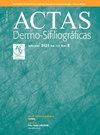低剂量口服米诺地尔治疗额部纤维化性脱发:122例病例系列。
IF 3.8
Q1 DERMATOLOGY
引用次数: 0
摘要
本研究的目的是分析口服米诺地尔对FFA患者额颞发际线的疗效。我们在2个巴西中心和1个西班牙中心进行了回顾性、描述性、多中心研究。回答以3分的正分制进行评分。共纳入122例患者。45.1%的患者主观观察到额颞发际线密度的改善,分为轻度(34.4%)、中度(9.0%)和优异(1.6%)。57.4%的患者壁间毛密度改善。此外,25.4%和3.3%的患者分别经历了眉毛和睫毛的生长。33.6%的患者出现不良反应,其中多毛最为常见(23.8%)。在本研究中,口服米诺地尔被证明是FFA的一种附加治疗,不仅改善了患者的整体头发和眉毛生长,而且还改善了额颞发际线的密度。本文章由计算机程序翻译,如有差异,请以英文原文为准。
![[Translated article] Low-dose Oral Minoxidil for Frontal Fibrosing Alopecia: A 122-patient Case Series](https://img.booksci.cn/booksciimg/2025-4/101302613091774566327.jpg)
[Translated article] Low-dose Oral Minoxidil for Frontal Fibrosing Alopecia: A 122-patient Case Series
The objective of our study was to analyze the effectiveness of oral minoxidil on the frontotemporal hairline in patients with FFA. We conducted a retrospective, descriptive, multicenter study in 2 Brazilian and 1 Spanish centers. Responses were graded on a scale of 3 positive points. A total of 122 patients were included. Subjective improvement in the density of the frontotemporal hairline was observed in 45.1% patients, which was categorized as mild (34.4%), moderate (9.0%), and excellent (1.6%). Hair density improved in 57.4% of the patients’ interparietal. Additionally, 25.4% and 3.3% of the patients experienced eyebrow and eyelash growth, respectively. Adverse effects were detected in 33.6% patients, with hypertrichosis being the most common (23.8%). In this study, oral minoxidil proved to be an additional therapy for FFA that not only improved the patients’ overall hair and eyebrow growth, but also the density of the frontotemporal hairline.
求助全文
通过发布文献求助,成功后即可免费获取论文全文。
去求助
来源期刊

Actas dermo-sifiliograficas
DERMATOLOGY-
CiteScore
1.90
自引率
9.40%
发文量
473
审稿时长
56 weeks
期刊介绍:
Actas Dermo-Sifiliográficas, publicación Oficial de la Academia Española de Dermatología y Venereología, es una revista de prestigio consolidado. Creada en 1909, es la revista mensual más antigua editada en España.En 2006 entró en Medline, y hoy resulta imprescindible para estar al día sobre la dermatología española y mundial.
 求助内容:
求助内容: 应助结果提醒方式:
应助结果提醒方式:


